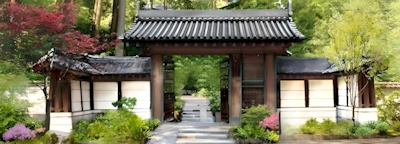Lauritzen Gardens (Future Japanese Garden)
Event Location
Riverview, NE 68108
Japanese Garden Dream Began Decades Ago
For decades predating the existence of Lauritzen Gardens, several Omaha citizens have dreamed of building a Japanese garden in Omaha. In 1995, Yuichi Kawai of Omaha's Sister City, Shizuoka, Japan, made a personal financial commitment to its creation by commissioning a Japanese garden design by Shinichiro Abe of ZEN Associates.
Based in Boston, Mass., ZEN Associates specializes in Japanese gardens, and one of their most well known projects is the Peace Bell Garden at the entrance to the United Nations building in New York City.
The gift of the garden design was officially presented to the City of Omaha and the garden in September of 1996 in celebration of the Omaha Sister Cities Association 30th anniversary with Shizuoka, Japan.
Japanese gardens are appreciated and admired in several major U.S. cities due to their unique visuals. To construct these living art forms, many American-Japanese collaborations, similar to Omaha's relationship with Shizuoka, have been created. The primary purpose of Japanese gardens in America is cultural communication.
The future Japanese garden's design includes central focus on a one-acre pond, with streams and waterfalls flowing into the pond. Also included will be an intimate ceremonial Japanese teahouse and dry sand and stone garden.
Japanese gardens found in the U.S. are not exact replicas of gardens found in Japan, though. Due to climate differences, they are interpretations that incorporate plants that are similar to plants found in Japan. The Japanese garden at Lauritzen Gardens will feature plants hardy in the Nebraska landscape, and while all plants found in traditional Japanese gardens may not be hardy, representational plants will be used.
The site at Lauritzen Gardens, west of the rose garden and south of the main pathway to the founders garden, was originally selected by Mr. Abe, the Japanese landscape architect who designed the garden. He was impressed with the feeling of the steep valley walls in the area that mirrored some of the topography in Japan, and because the garden design is oriented around a large pond, the site is visually conducive to having a body of water at its base.
The biggest noticeable difference between American gardens and Japanese gardens is in maintenance techniques. Japanese gardens are finely manicured to instill specific characteristics on the plants rather than letting them grow wild and natural. These sculptural trimming techniques are highly labor intensive and are performed on a frequent basis. The end product is a garden that looks like it has existed for centuries and communicates an ancient feeling.
The future Lauritzen Gardens Japanese garden will be the largest between Chicago and Denver, and is part of the garden's 'Phase 3' capital campaign. Once dollars are raised, it is estimated to take two years to build. A construction start date has not been set. The design of this outstanding Japanese garden was a 30th anniversary gift to the people of the City of Omaha from Mr. Yuichi Kawai who has been involved with the Sister City relationship between Omaha and Shizuoka for many years.
Contact
Phone: (402) 346-4002Location Website
Click to Visit
(For Event Information See Event Website Page)
Authentic Japanese Gardens (United States)
Best Japanese Gardens
Japanese Rock 'Zen' Gardens (United States)
Best Japanese Rock 'Zen' Gardens
Japanese Teahouses (United States)
Best Japanese Teahouses
Japanese Museum Art
Japanese Museums Map of Japanese Museums

















